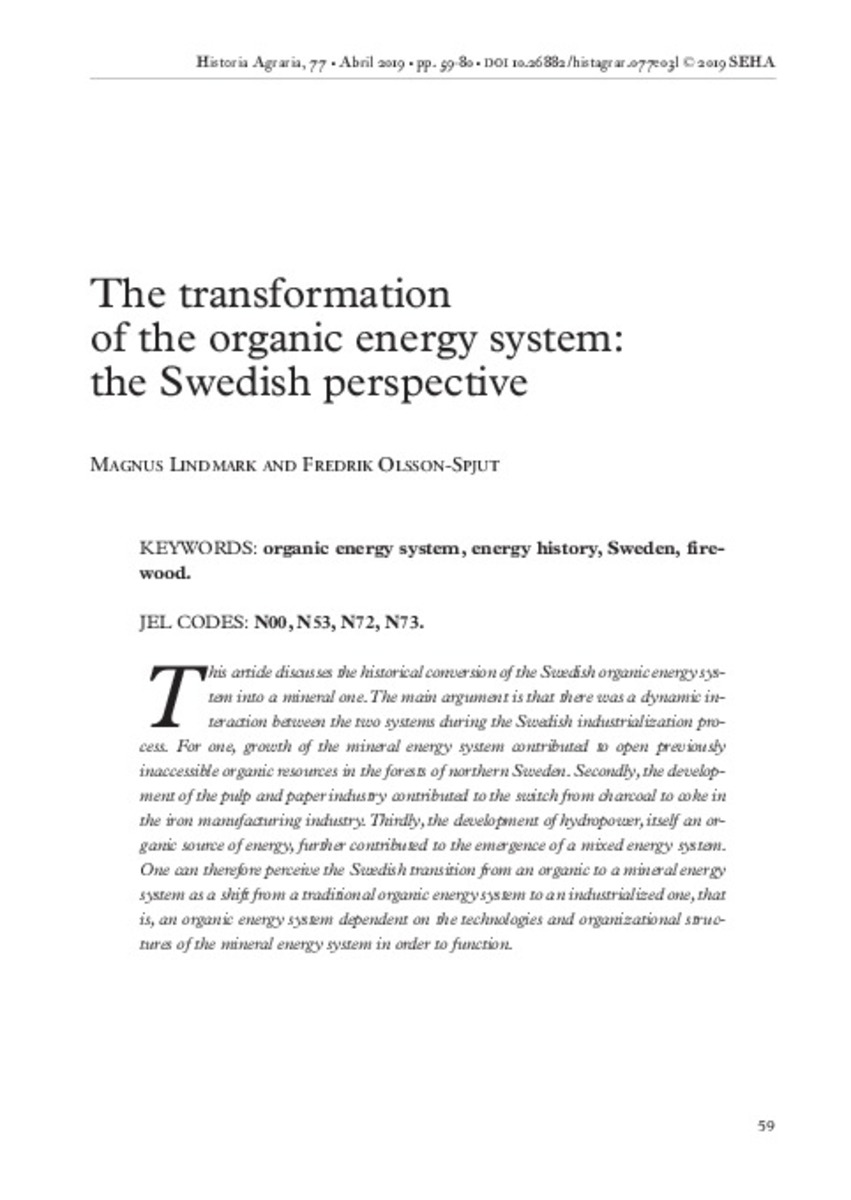Mostrar el registro sencillo del ítem
The transformation of the organic energy system: the Swedish perspective
| dc.contributor.author | Lindmark, Magnus | |
| dc.contributor.author | Olsson-Spjut, Fredrik | |
| dc.date.accessioned | 2019-03-07T11:08:14Z | |
| dc.date.available | 2019-03-07T11:08:14Z | |
| dc.date.issued | 2019-04 | |
| dc.identifier.issn | 1139-1472 | |
| dc.identifier.uri | http://hdl.handle.net/10234/181749 | |
| dc.description.abstract | This article discusses the historical conversion of the Swedish organic energy system into a mineral one. The main argument is that there was a dynamic interaction between the two systems during the Swedish industrialization process. For one, growth of the mineral energy system contributed to open previously inaccessible organic resources in the forests of northern Sweden. Secondly, the development of the pulp and paper industry contributed to the switch from charcoal to coke in the iron manufacturing industry. Thirdly, the development of hydropower, itself an organic source of energy, further contributed to the emergence of a mixed energy system. One can therefore perceive the Swedish transition from an organic to a mineral energy system as a shift from a traditional organic energy system to an industrialized one, that is, an organic energy system dependent on the technologies and organizational structures of the mineral energy system in order to function. | ca_CA |
| dc.description.abstract | En este artículo se analiza en perspectiva histórica la transición de un sistema energético orgánico a otro mineral para el caso de Suecia. Los principales argumentos son que en el proceso de industrialización sueco hubo una interacción dinámica entre ambos sistemas. En primer lugar, observamos que la expansión del sistema energético mineral facilitó el acceso a recursos orgánicos en el norte de Suecia, antes inaccesibles. En segundo lugar, comprobamos que el auge de la industria papelera fue un factor clave en la transición de le industria del hierro desde el carbón vegetal al coque. En tercer lugar, el desarrollo de la energía hidráulica, una fuente de energía orgánica, contribuyó adicionalmente a la coexistencia de un sistema energético mixto. Planteamos, por tanto, que la transición de un sistema energético orgánico a uno mineral en Suecia puede entenderse como el cambio de un sistema de energía orgánica tradicional a otro también orgánico pero industrializado, esto es, a un sistema energético que para su funcionamiento era dependiente de tecnologías y estructuras organizativas del sistema mineral. | ca_CA |
| dc.format.extent | 22 p. | ca_CA |
| dc.format.mimetype | application/pdf | ca_CA |
| dc.language.iso | eng | ca_CA |
| dc.publisher | Sociedad Española de Historia Agraria (SEHA) | ca_CA |
| dc.relation.isPartOf | Historia agraria: Revista de agricultura e historia rural, nº 77, 59-80 | ca_CA |
| dc.rights | Attribution-NonCommercial-NoDerivatives 4.0 Internacional | ca_CA |
| dc.rights.uri | http://creativecommons.org/licenses/by-nc-nd/4.0/ | |
| dc.subject | organic energy system | ca_CA |
| dc.subject | energy history | ca_CA |
| dc.subject | Sweden | ca_CA |
| dc.subject | firewood | ca_CA |
| dc.subject | sistema energético orgánico | ca_CA |
| dc.subject | historia de la energía | ca_CA |
| dc.subject | Suecia | ca_CA |
| dc.subject | leña | ca_CA |
| dc.title | The transformation of the organic energy system: the Swedish perspective | ca_CA |
| dc.type | info:eu-repo/semantics/article | ca_CA |
| dc.subject.jel | N00 | ca_CA |
| dc.subject.jel | N53 | ca_CA |
| dc.subject.jel | N72 | ca_CA |
| dc.subject.jel | N73 | ca_CA |
| dc.identifier.doi | http://dx.doi.org/10.26882/histagrar.077e03l | |
| dc.rights.accessRights | info:eu-repo/semantics/openAccess | ca_CA |
| dc.relation.publisherVersion | http://www.historiaagraria.com/es/numeros/n77 | ca_CA |








